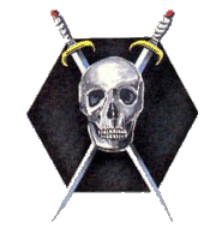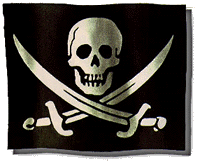
|
Welcome to Our Home Port
Welcom aboard mate. We are the Belt Pirates of the MechLord Leauge. We are dedicated to only one thing; getting rich. We will raid and plunder from anyone in the leauge. We have no freinds and plenty of enemies. If your looking for a good battle and the riches of plunder you have come to the right outfit. !
Belt Pirates of Old
At the end of the Reunification Wars, those Rim Republic citizens and
soldiers who refused to lay down their arms fled the Republic and settled
themselves on another world, where they became notorious for their piratical
raids and assaults into the Inner Sphere. Highly organized as they came from a
well-trained military, the Belt Pirates continued, successfully, their piratical
activities throughout the generations. Sometimes the pirates even hired
themselves out to the Successor States as thugs for hire, willing to perform
certain operations that no self-respecting mercenary unit would ever consider.
|
 The Flag Of "Calico" Jack Rackham
The Flag Of "Calico" Jack Rackham
|
Jolly Roger
The Jolly Roger, Old Roger, or just plain Skull and Crossbones is the definitive symbol of the pyrate. Although no one knows for certain, it is believed that the name derives from joli rouge, which means "Pretty Red" in French. This was taken to describe the blood red flags flown by particularly harsh pyrates. No matter where the name came from, the essential use of this banner was to strike fear into the hearts of the crew under pyrate attack. While pyrates often flew "false colours" of any given country, inevitably they used "truer" colours to communicate and threaten potential victims.
Around 1700 the first such flag was flown by Emmanuel Wynne as he plundered the Caribbean. In general, a white flag was flown when pyrates were in chase of a potential victim. In some cases the victim would "strike his colours", or take down the king's flag and submit to the bandits. If the victims refused, the black and white flag was raised to indicate the intentions of the pyrates. In the event that a ship was particularly evasive, or a pyrate was particularly brutal, the red flag was raised to indicate that no quarter would be given once the ship was captured. In short no lives would be spared. The flags contained symbols designed to indicate a certain message. Of course, the skull was a sign of death in general, but a skeleton, often with horns, was to indicate a tormented death. On the otherhand, a dart or spear was used to indicate a violent death in contrast to the bleeding heart denoting a slow and painful death. A raised fist or hand clutching a dagger or cutlass was to indicate a general willingness to kill and the hourglass gave a threat that time was running out or that capture was inevitable. Curiously, Blackbeard managed to incorporate practically every one of these main symbols into his flag. Jack Rackham (Calico Jack) used a graceful set of crossed swords in place of bones to boast ironically of his willingness to fight. Similarly, Thomas Tew took the image of the sword before that of death. In his flag, no symbol of death is present, but the message is no less clear regarding the fate of any who opposed his advance. Sir Thomas Tew seemed to think it more polite to suggest violence without that nasty death image. These images were, of course, interpretive, but well known in the golden age of pyracy. A flag could be a simple variation like Henry Every's (page top) skull at a profile, or it could be all inclusive like Stede Bonnet's rather bland jumble of images. As was the case often, a flag could be altered or customized to fit a particular need.
|
|